Life Cycle Assessment of Selected Single-Use Plastic Products towards Evidence-Based Policy Recommendations in Sri Lanka
Abstract
:1. Introduction
2. Materials and Methods
2.1. LCA Methodology—ISO 14040/14044
- Goal and scope definition: The goal and scope phase defines the purpose of the study, the intended use of the results, and what should be included.
- Life cycle inventory (LCI): The life cycle inventory phase involves the compilation and quantification of inputs and outputs for a product throughout its life cycle.
- Life cycle impact assessment (LCIA): The life cycle impact assessment phase is aimed at understanding and evaluating the magnitude and significance of the potential environmental impacts of a product system, throughout the life cycle of the product.
- Interpretation of results: The life cycle assessment phase, in which the findings of either the inventory analysis or the impact assessment, or both, is evaluated in relation to the defined goal and scope to reach conclusions and provide recommendations.
2.2. Goal and Scope Definition
2.2.1. Goal, Functional Unit (FU), and System Boundaries
2.2.2. General Data and Assumptions
2.3. Life-Cycle Inventory
2.4. Life Cycle Impact Assessment
2.5. Sri Lankan Situation of SUPPs Regulating Process
3. Results
3.1. Life Cycle Inventory
3.2. Life Cycle Impact of SUPPs and Alternative Products
3.2.1. Cutlery (Fork/Spoon)
3.2.2. Cotton Bud
3.2.3. Joss-Stick Wrappers
3.2.4. Cloth Wick Wrappers
3.2.5. Pesticide Bottle
3.2.6. Grocery Bag
3.2.7. Straws
3.2.8. Water Bottle
3.3. Sri Lankan Situation of SUPPs Regulating Process
4. Discussion
4.1. Life Cycle Inventory (LCI) Data in Sri Lanka
4.2. Interpretation of Life Cycle Impact Assessment (LCIA)
4.2.1. Global Warming Potential (GWP)
4.2.2. Mid and Endpoint Impact Categories
4.3. Policy Recommendations
4.4. Challenges of LCA as a Tool for Policy Recommendation in Sri Lanka
5. Conclusions
- Promoting al and steel (multiple cycles) products will be beneficial for the significant GWP reduction.
- Even though fossil fuel-based SUPPs with the ability for multiple uses and proper recycling practices can be recommendable.
- PLA-based single-use products are not recommended by the CEA, Sri Lanka due to the limited capacity in the country for monitoring and quality control of PLA-based SUPPs.
- Accumulation of the available data in a usable form in a national database will be essential for promoting LCT and LCA approaches in Sri Lanka.
- National-level LCI data is crucial for the decision-making process in implementing sustainable development practices.
- Incorporating Sri Lankan LCI databases with commercial LCA software is an essential initiative.
- LCA results provide policymakers the science-based evidence that embraces the full life cycle of plastic products and alternatives to support decision making however it is equally important to consider the social and economic aspects while making decisions.
- Hence, future studies should explore more alternatives for selected SUPPs for analyzing not only the environment but also the social and economic impact of the SUPPs in Sri Lanka.
- The study also identified the importance of addressing single-use plastic in a more holistic manner rather than just taking policy decisions to ban and leave selected SUPPs. These policy decisions may cause increasing environmental pollution. The planning of addressing single-use plastic start with assessing the existing single-use plastic materials and products and their alternatives using the LCA. This helps to target the most problematic single-use plastics, assess their impacts and consider the best actions. These actions need to cover a more circular model of design and production of plastic materials to improve waste management practices to handle those which cannot further reuse or recycle.
Supplementary Materials
Author Contributions
Funding
Data Availability Statement
Acknowledgments
Conflicts of Interest
References
- UNEP. United Nations Environment Assembly of the United Nations Environment Programme. 2022. Available online: https://wedocs.unep.org/bitstream/handle/20.500.11822/38525/k2200647_-_unep-ea-5-l-23-rev-1_-_advance.pdf?sequence=1&isAllowed=y (accessed on 18 July 2022).
- Moretti, C.; Hamelin, L.; Jakobsen, L.G.; Junginger, M.H.; Steingrimsdottir, M.M.; Høibye, L.; Shen, L. Cradle-to-grave life cycle assessment of single-use cups made from PLA, PP and PET. Resour. Conserv. Recycl. 2021, 169, 105508. [Google Scholar] [CrossRef]
- Gursel, I.V.; Moretti, C.; Hamelin, L.; Jakobsen, L.G.; Steingrimsdottir, M.M.; Junginger, M.; Høibye, L.; Shen, L. Comparative cradle-to-grave life cycle assessment of bio-based and petrochemical PET bottles. Sci. Total Environ. 2021, 793, 148642. [Google Scholar] [CrossRef] [PubMed]
- Herberz, T.; Barlow, C.Y.; Finkbeiner, M. Sustainability assessment of a single-use plastics ban. Sustainability 2020, 12, 3746. [Google Scholar] [CrossRef]
- Majeed, K.; Jawaid, M.; Hassan, A.A.; Bakar, A.A.; Khalil, H.A.; Salema, A.A.; Inuwa, I. Potential materials for food packaging from nanoclay/natural fibres filled hybrid composites. Mater. Des. 2013, 46, 391–410. [Google Scholar] [CrossRef]
- Jayalath, G.N.; Thilakarathne, E.P.; Abeygunawardana, A.P.; Silva, A.P.; Egodauyana, K.P.; Nawarathna, A.M.; Gunasekara, A.J. Status of Plastic Waste Generation and Propose a Circular Economy-Based Policy Framework to Manage Plastic Waste in Sri Lanka. IOSR J. Environ. Sci. Toxicol. Food Technol. 2021, 15, 24–38. [Google Scholar]
- Plastic Waste Management, Country Situation Report—Sri Lanka. 2021. Available online: https://ipen.org/sites/default/files/documents/plastic_waste_management_in_sri_lanka.pdf (accessed on 18 July 2022).
- United Nations Environment Programme; World Travel & Tourism Council. Rethinking Single-Use Plastic Products in Travel & Tourism—Impacts, Management Practices and Recommendations; UNEP: Nairobi, Kenya; World Travel & Tourism Council: London, UK, 2021. [Google Scholar]
- Kaluarachchi, K.A.U.A.; Thathsarani, M.; Nilmini, W.; Namal Arachchi, N.A.K.A.; Silva, J.L.K.C. Current plastic wastage and introducing new innovations to minimize plastic wastage in Sri Lanka. J. Res. Technol. Eng. 2017, 1, 4–10. [Google Scholar]
- Shantha, A.A.; Samarakoon, A. Cost Benefit Analysis for the National Post Consumer Plastic Waste Management Project; Central Environmental Authority: Colombo, Sri Lanka, 2018. [Google Scholar]
- Ministry of Environment, Sri Lanka. National Action Plan on Plastic Waste Management. 2021. Available online: https://www.ccet.jp/sites/default/files/2021-08/srilanka_report_web_fin_pw.pdf (accessed on 18 July 2022).
- Japan International Cooperation Agency, Kokusai Kogyo Co, Ltd. Data Collection Survey on Solid Waste Management in Democratic Socialist Republic of Sri Lanka Final Report Democratic Socialist Republic of Sri Lanka Japan International Cooperation Agency (JICA) Ten (10) Priority Local Authorities; Japan International Cooperation Agency; Kokusai Kogyo Co., Ltd.: Tokoyo, Japan, 2016; p. 22. Available online: http://open_jicareport.jica.go.jp/pdf/12250213.pdf (accessed on 16 July 2022).
- UNEP. Legal Limits on Single-Use Plastics and Microplastics: A Global Review of National Laws and Regulations. 2018. Available online: https://www.unep.org/resources/publication/legal-limits-single-use-plastics-and-microplastics-global-review-national (accessed on 21 October 2022).
- Life Cycle Initiative. What is Life Cycle Thinking. 2022. Available online: https://www.lifecycleinitiative.org/starting-life-cycle-thinking/what-is-life-cycle-thinking/ (accessed on 18 July 2022).
- Kumarasena, S.; Weerathunga, U.A.; Rathnayake, M. Development of National LCA Database Roadmaps, Including Further Development of the Technical Helpdesk for National LCA Databases; Life Cycle Initiative: Paris, France; UNEP: Nairobi, Kenya, 2022; Available online: https://helpdesk.lifecycleinitiative.org/wp-content/uploads/2020/11/d_4.4_final_roadmap_report_lk.pdf (accessed on 18 July 2022).
- UNEP. Addressing Single-Use Plastic Products Pollution. 2019. Available online: https://wedocs.unep.org/bitstream/handle/20.500.11822/28473/English.pdf?sequence=3&isAllowed=y (accessed on 18 July 2022).
- UNEP. End Plastic Pollution: Towards an International Legally Binding Instrument, 2022. UNEP Document Repository. Available online: https://wedocs.unep.org/handle/20.500.11822/38525 (accessed on 18 July 2022).
- Life Cycle Initiative. Single-Use Plastic Products (SUPP) and Their Alternatives: Recommendations from Life Cycle Assessments. 2022. Available online: https://www.lifecycleinitiative.org/activities/key-programme-areas/technical-policy-advice/single-use-plastic-products-studies/ (accessed on 18 July 2022).
- Woods, J.S.; Verones, F.; Jolliet, O.; Vázquez-Rowe, I.; Boulay, A.M. A framework for the assessment of marine litter impacts in life cycle impact assessment. Ecol. Indic. 2021, 129, 107918. [Google Scholar] [CrossRef]
- Ng, C.Y. Green product design and development using life cycle assessment and ant colony optimization. Int. J. Adv. Manuf. Technol. 2018, 95, 3101–3109. [Google Scholar] [CrossRef]
- ISO 14040:2006; Environmental Management—Life Cycle Assessment—Principles and Framework. International Organization for Standardization: Geneve, Switzerland, 2006.
- ISO 14044:2006; Environmental Management—Life Cycle Assessment—Requirements and Guidelines. International Organization for Standardization: Geneve, Switzerland, 2006.
- Bouyarmane, H.; Sallaou, M. Environmental assessment in the early stages of product design. In Proceedings of the 5th International Conference on Optimization and Applications (ICOA), Kenitra, Morocco, 25–26 April 2019; pp. 1–5. [Google Scholar]
- Luthe, T.; Kägi, T.; Reger, J. A systems approach to sustainable technical product design: Combining life cycle assessment and virtual development in the case of skis. J. Ind. Ecol. 2013, 17, 605–617. [Google Scholar] [CrossRef]
- CEA. Regulations on Polythene & Plastic Management 2017. Available online: http://www.cea.lk/web/?option=com_content&view=article&layout=edit&id=1080 (accessed on 18 July 2022).
- Fernando, S. (Ministry of Environment, Colombo, Sri Lanka). Personal communication, 2021. [Google Scholar]
- Jem, K.J.; Tan, B. The development and challenges of poly (lactic acid) and poly (glycolic acid). Adv. Ind. Eng. Polym. Res. 2020, 3, 60–70. [Google Scholar] [CrossRef]
- Sombatsompop, N.; Srimalanon, P.; Markpin, T.; Prapagdee, B. Polylactic Acid (PLA): Improve It, Use It, and Dump It Faster. BioResources 2021, 16, 2196–2199. [Google Scholar] [CrossRef]
- Zanghelini, G.M.; Cherubini, E.; Dias, R.; Kabe, Y.H.; Delgado, J.J. Comparative life cycle assessment of drinking straws in Brazil. J. Clean. Prod. 2020, 276, 123070. [Google Scholar] [CrossRef]
- Tamburini, E.; Costa, S.; Summa, D.; Battistella, L.; Fano, E.A.; Castaldelli, G. Plastic (PET) vs. bioplastic (PLA) or refillable aluminium bottles–What is the most sustainable choice for drinking water? A life-cycle (LCA) analysis. Environ. Res. 2021, 196, 110974. [Google Scholar] [CrossRef] [PubMed]
- Ferrara, C.; De Feo, G.; Picone, V. LCA of Glass Versus PET Mineral Water Bottles: An Italian Case Study. Recycling 2021, 6, 50. [Google Scholar] [CrossRef]
- Democratic Socialist Republic of Sri Lankan Parliament Secretariat. The Constitution of the Democratic Socialist Republic of Sri Lanka, Revised ed.—2021. Available online: https://www.parliament.lk/files/pdf/constitution.pdf (accessed on 18 July 2022).
- Code of Criminal Procedure. 1979. Available online: https://www.lawnet.gov.lk/code-of-criminal-procedure-2/ (accessed on 18 July 2022).
- National Environmental (Amendment) Act, No. 53 of 2000. Available online: http://www.cea.lk/web/images/pdf/acts/act53-2000.pdf (accessed on 18 July 2022).
- National Environment Policy and Strategies. 2003. Available online: http://extwprlegs1.fao.org/docs/pdf/srl174812.pdf (accessed on 18 July 2022).
- National Policy and Strategy for Cleaner Production. 2005. Available online: https://policy.asiapacificenergy.org/sites/default/files/National%20Policy%20and%20Strategy%20for%20Cleaner%20Production.pdf (accessed on 18 July 2022).
- Bandara, S. National Policy on Solid Waste Management and Implementation Mechanisms in Sri Lanka. Available online: https://www.unescap.org/sites/default/files/2_MoE_S%20Bandara.pdf (accessed on 18 July 2022).
- Parliament of the Democratic Socialist Republic of Sri Lanka. Marine Pollution Prevention ACT, No. 35 OF 2008. Available online: https://www.lawnet.gov.lk/wp-content/uploads/2016/12/MARINE-POLLUTION-PREVENTION-ACT-NO-35-OF-2008.pdf (accessed on 18 July 2022).
- Chaturika. A Critical Analysis of Environmental taxation for Sri Lanaka in a Sustainomic Framework. 2014. Available online: http://dl.lib.uom.lk/bitstream/handle/123/11371/105333.pdf?sequence=1&isAllowed=y (accessed on 18 July 2022).
- National Environment Policy. 2021. Available online: https://www.env.gov.lk/web/images/pdf/notices/2021/NationalEnvPolicy2021_final_draft_public_comments_English.pdf (accessed on 18 July 2022).
- Ban on sachets, PET, PVC from March 31. 2021. Available online: http://dailynews.lk/2021/02/22/local/242205/ban-sachets-pet-pvc-march-31 (accessed on 18 July 2022).
- Democratic Socialist Republic of Sri Lankan Ministry of Environment. National Action Plan on Plastic Waste Management 2021–2030. 2021. Available online: http://env.gov.lk/web/images/pdf/policies/National_Action_Plan_on_Waste_Management.pdf (accessed on 18 July 2022).
- UNEP. Addressing Single-Use Plastic Products Pollution Using a Life Cycle Approach. 2021. Available online: https://www.lifecycleinitiative.org/wp-content/uploads/2021/02/Addressing-SUP-Products-using-LCA_UNEP-2021_FINAL-Report-sml.pdf (accessed on 18 July 2022).
- NEP. 2019. Available online: http://env.gov.lk/web/images/pdf/policies/National_Action_Plan_on_Waste_Management.pdf (accessed on 18 July 2022).
- Vora, N.; Christensen, P.R.; Demarteau, J.; Baral, N.R.; Keasling, J.D.; Helms, B.A.; Scown, C.D. Leveling the cost and carbon footprint of circular polymers that are chemically recycled to monomer. Sci. Adv. 2021, 7, eabf0187. [Google Scholar] [CrossRef] [PubMed]
- Ishikawa, Y.; Herat, S. Use of Cement Kilns for Managing Hazardous Waste in Developing Countries. In Waste To Energy; Springer: London, UK, 2012; pp. 137–155. [Google Scholar]
- Wei, F.; Tan, Q.; Dong, K.; Li, J. Revealing the feasibility and environmental benefits of replacing disposable plastic tableware in aviation catering: An AHP-LCA integrated study. Resour. Conserv. Recycl. 2022, 187, 106615. [Google Scholar] [CrossRef]
- JAK. Recycling of waste plastics, HDPE, LDPE, and PP. 2022. Available online: https://jakplastics.lk/jakrecyclecenter.php (accessed on 20 October 2022).
- Liu, C.; Nguyen, T.T.; Ishimura, Y. Current situation and key challenges on the use of single-use plastic in Hanoi. Waste Manag. 2021, 121, 422–431. [Google Scholar] [CrossRef] [PubMed]
- Life Cycle Initiative. Single-Use Plastic Bags and Their Alternatives: Recommendations from Life Cycle Assessments. 2020. Available online: https://www.lifecycleinitiative.org/single-use-plastic-bags-and-their-alternatives-recommendations-from-life-cycle-assessments/ (accessed on 20 October 2022).
- Pathwater. Sustainable Bottled Water, the PATHWATER Life Cycle Assessment. 2019. Available online: https://drinkpathwater.com/blogs/news/sustainable-bottled-water-the-pathwater-life-cycle-assessment (accessed on 20 October 2022).
- Bałdowska-Witos, P.; Piasecka, I.; Flizikowski, J.; Tomporowski, A.; Idzikowski, A.; Zawada, M. Life Cycle Assessment of Two Alternative Plastics for Bottle Production. Materials 2021, 14, 4552. [Google Scholar] [CrossRef] [PubMed]
- Abeynayaka, A.; Norihiro, I. A Framework to Incorporate Aquatic Plastic into Life Cycle Assessment of Plastic Products. In Proceedings of the 11th International Symposium on Environmentally Conscious Design and Inverse Manufacturing (EcoDesign 2019), Yokohama, Japan, 25–27 November 2019; pp. 261–265. [Google Scholar]
- Corella-Puertas, E.; Guieu, P.; Aufoujal, A.; Bulle, C.; Boulay, A.-M. Development of simplified characterization factors for the assessment of expanded polystyrene and tire wear microplastic emissions applied in a food container life cycle assessment. J. Ind. Ecol. 2022, 1–13. [Google Scholar] [CrossRef]
- Biodiversity Sir Lanka. Moves to Establish and Operationalize Private Sector Consortia to Facilitate Extended Producer Responsibility (EPR) Implementation. 2022. Available online: https://biodiversitysrilanka.org/moves-to-establish-and-operationalize-private-sector-consortia-to-facilitate-epr-implementation/ (accessed on 20 October 2022).
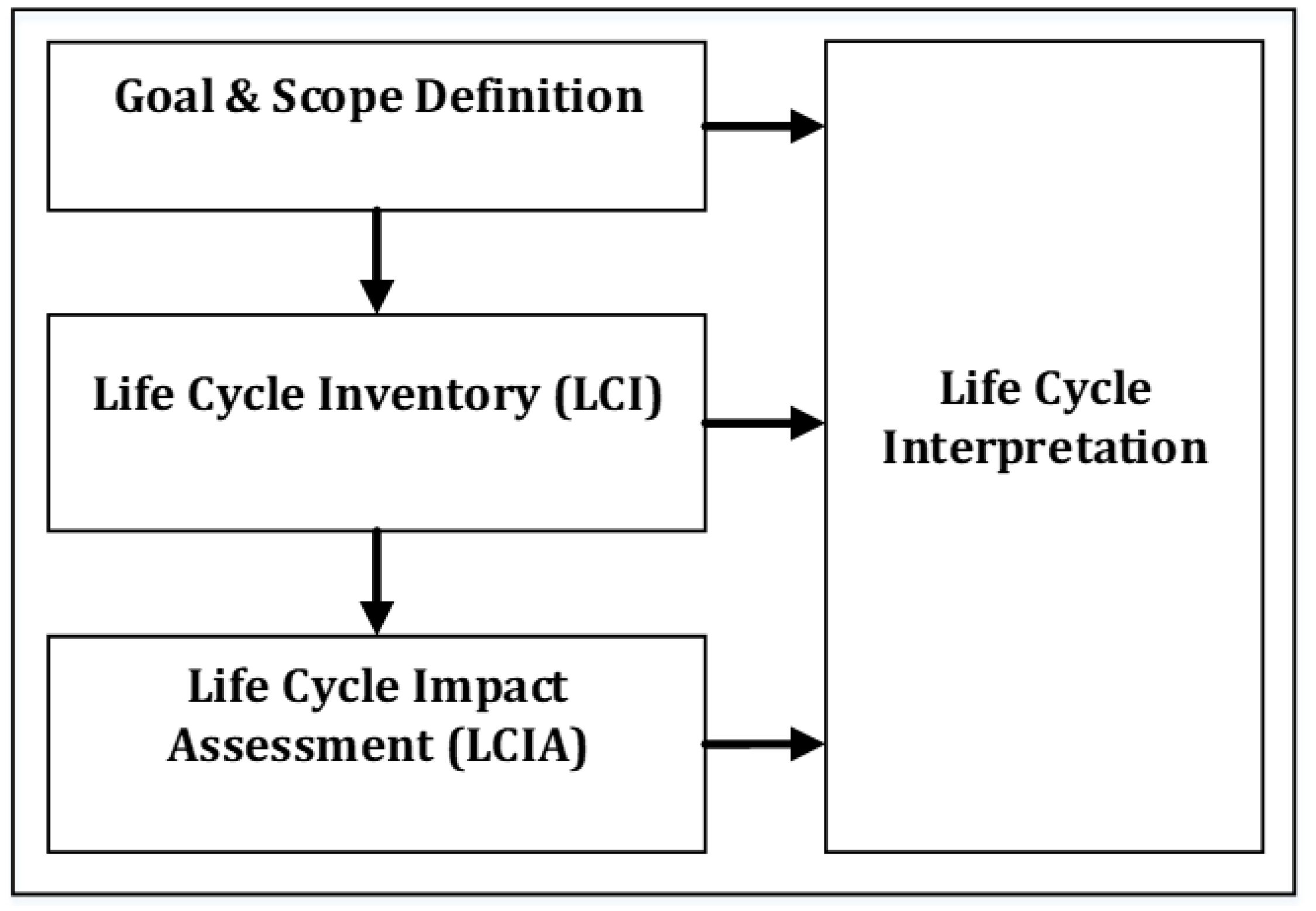
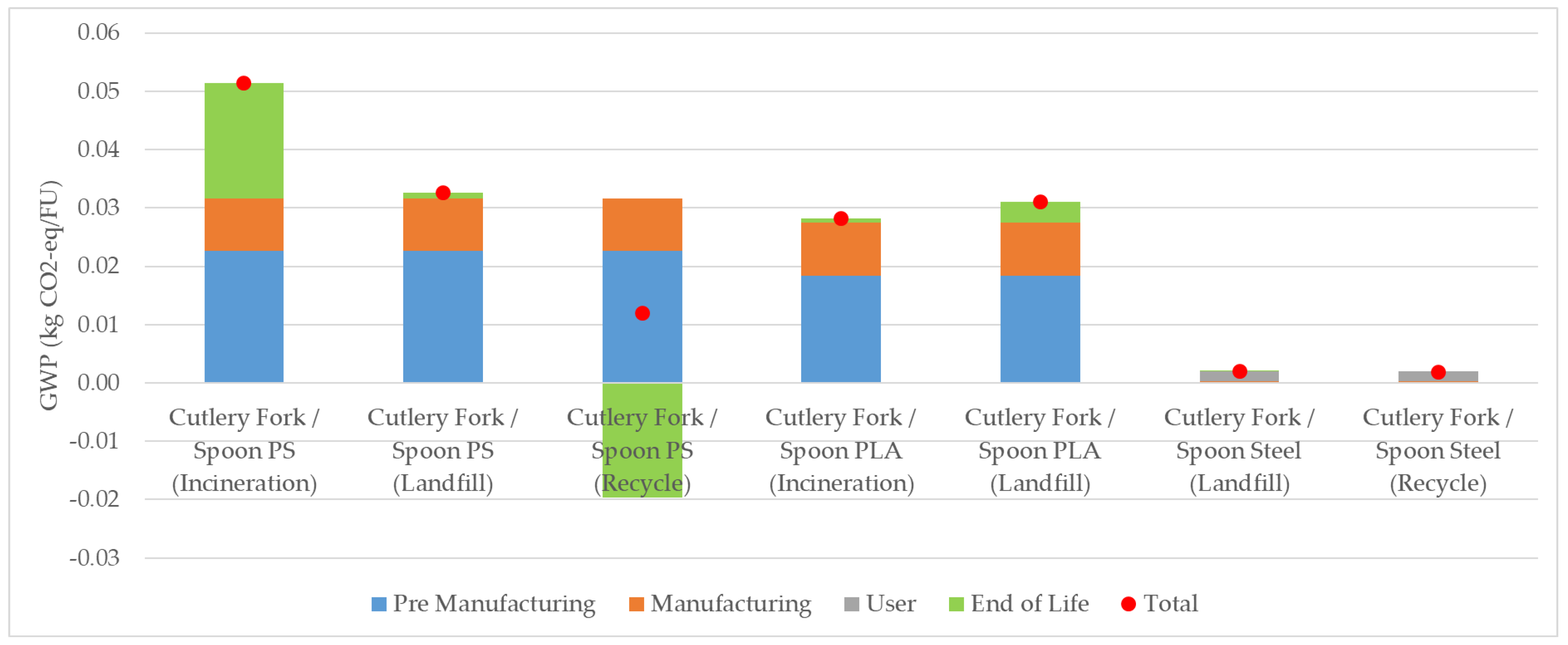
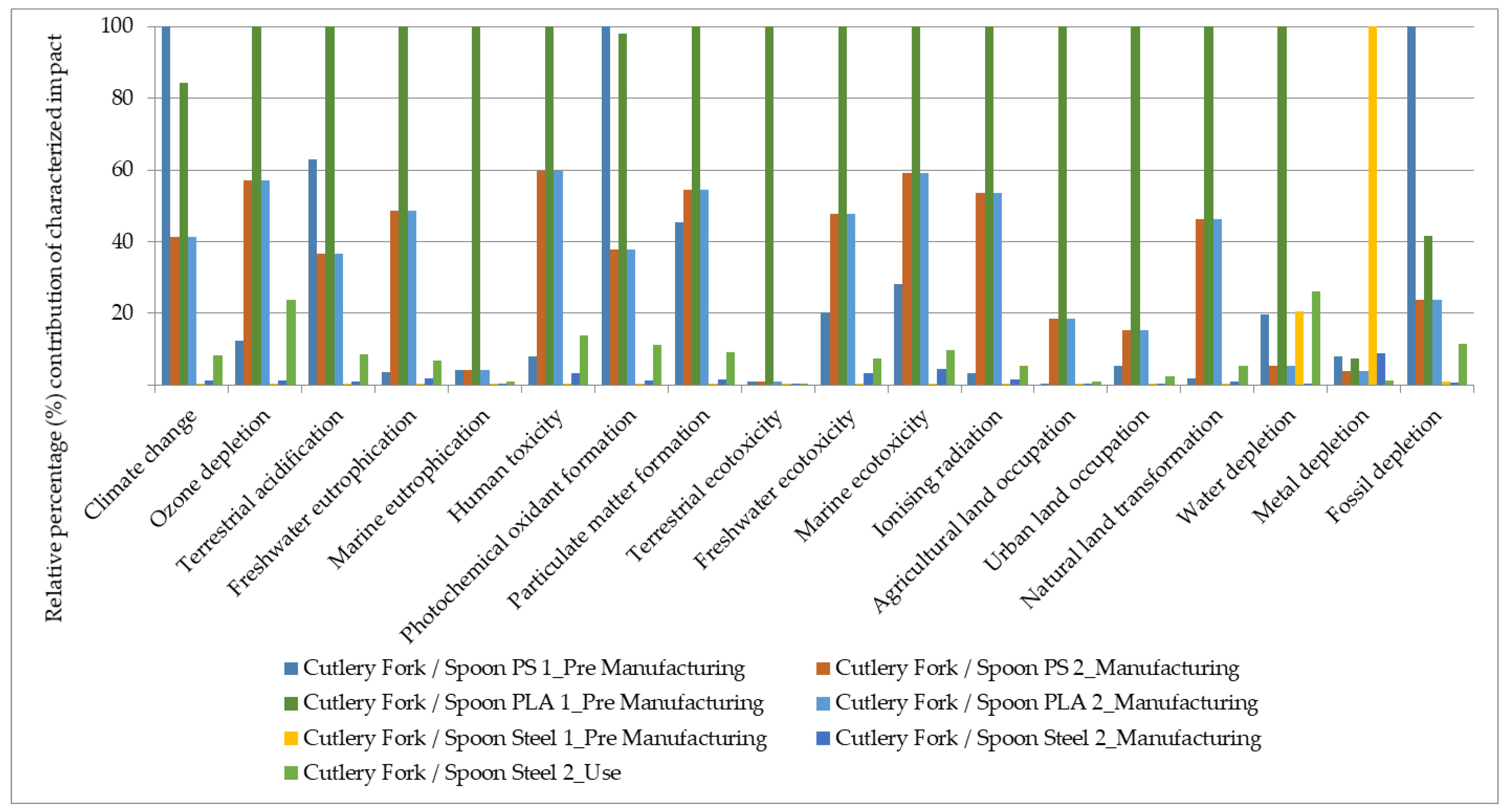

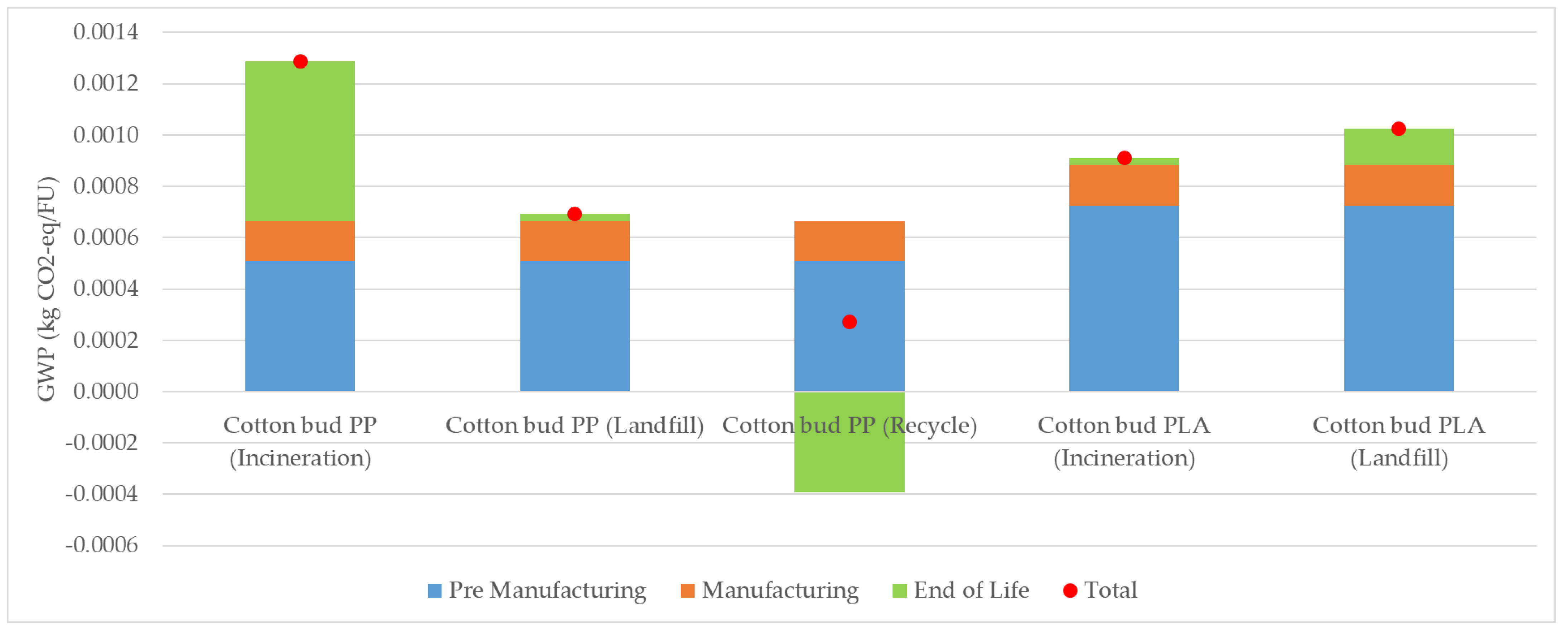
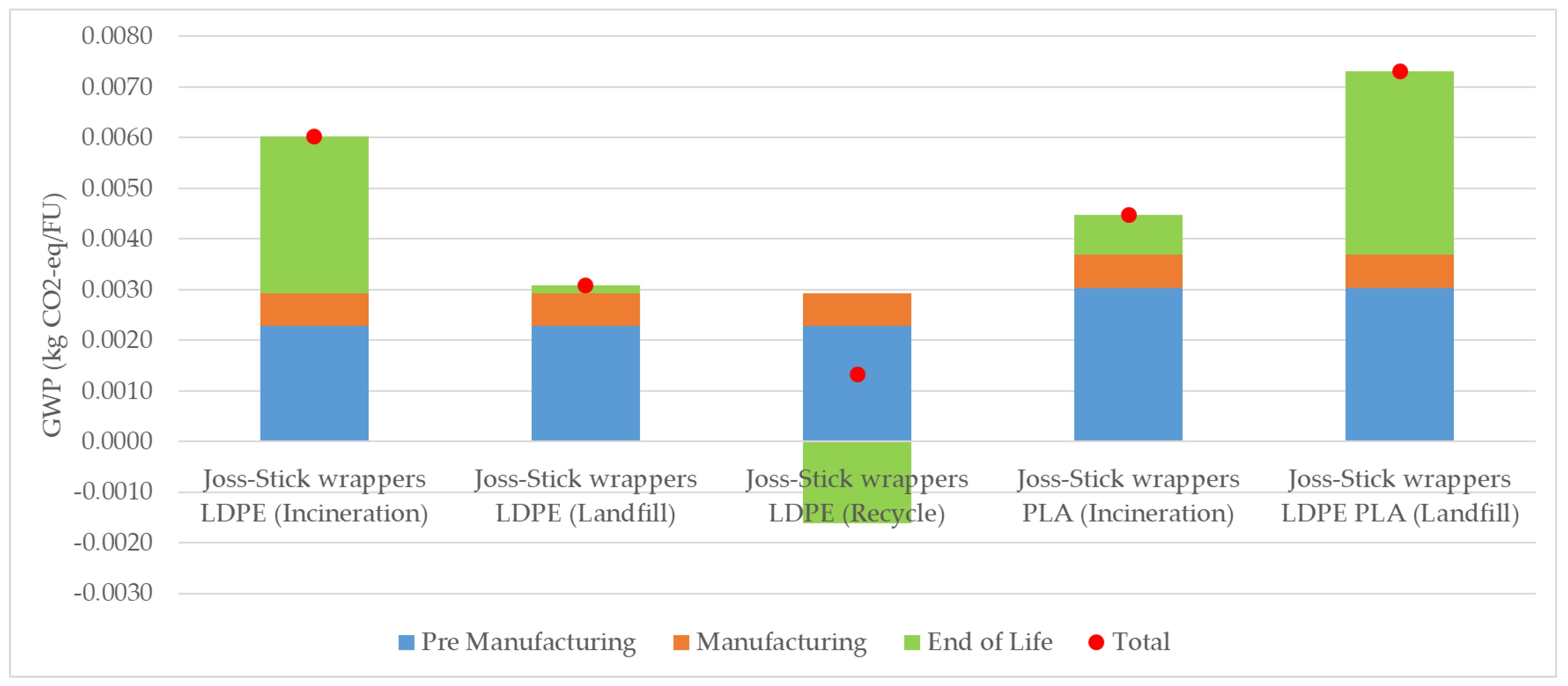



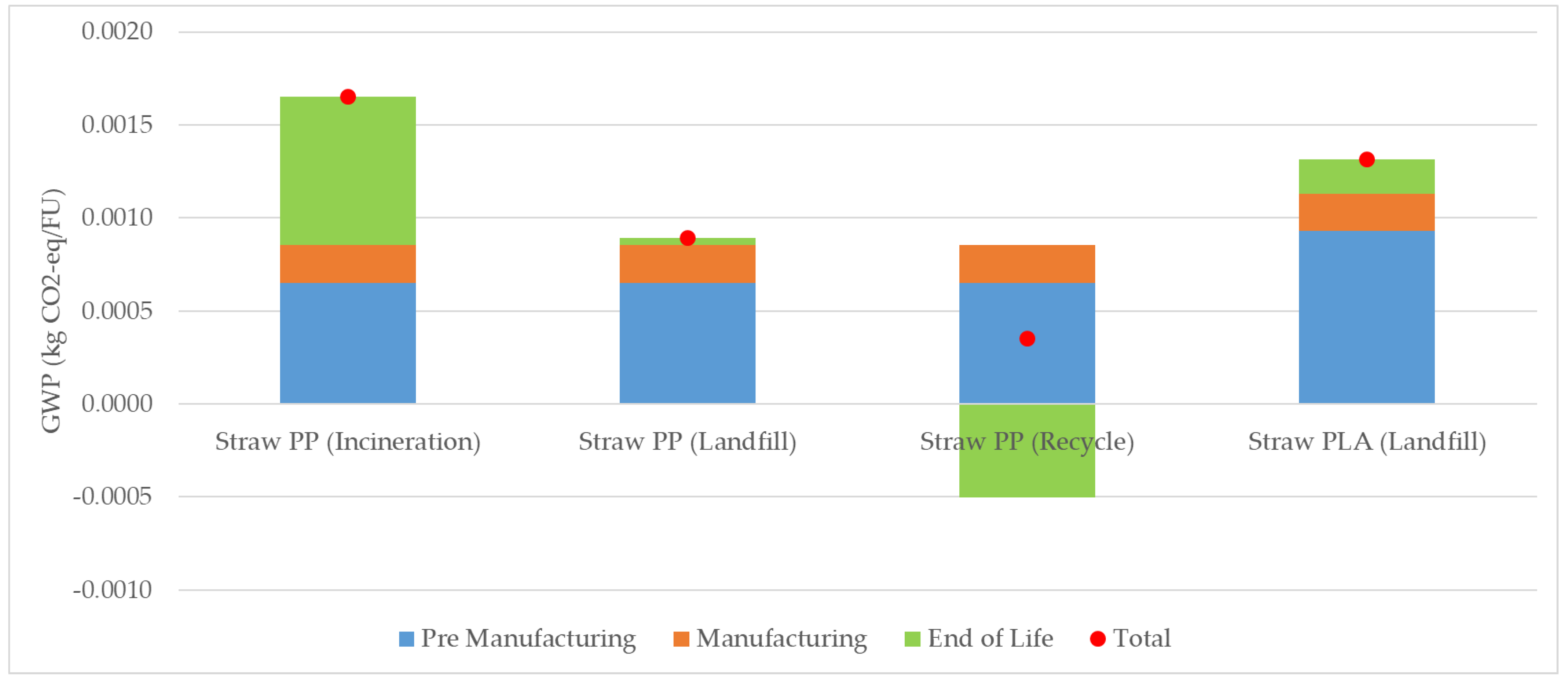
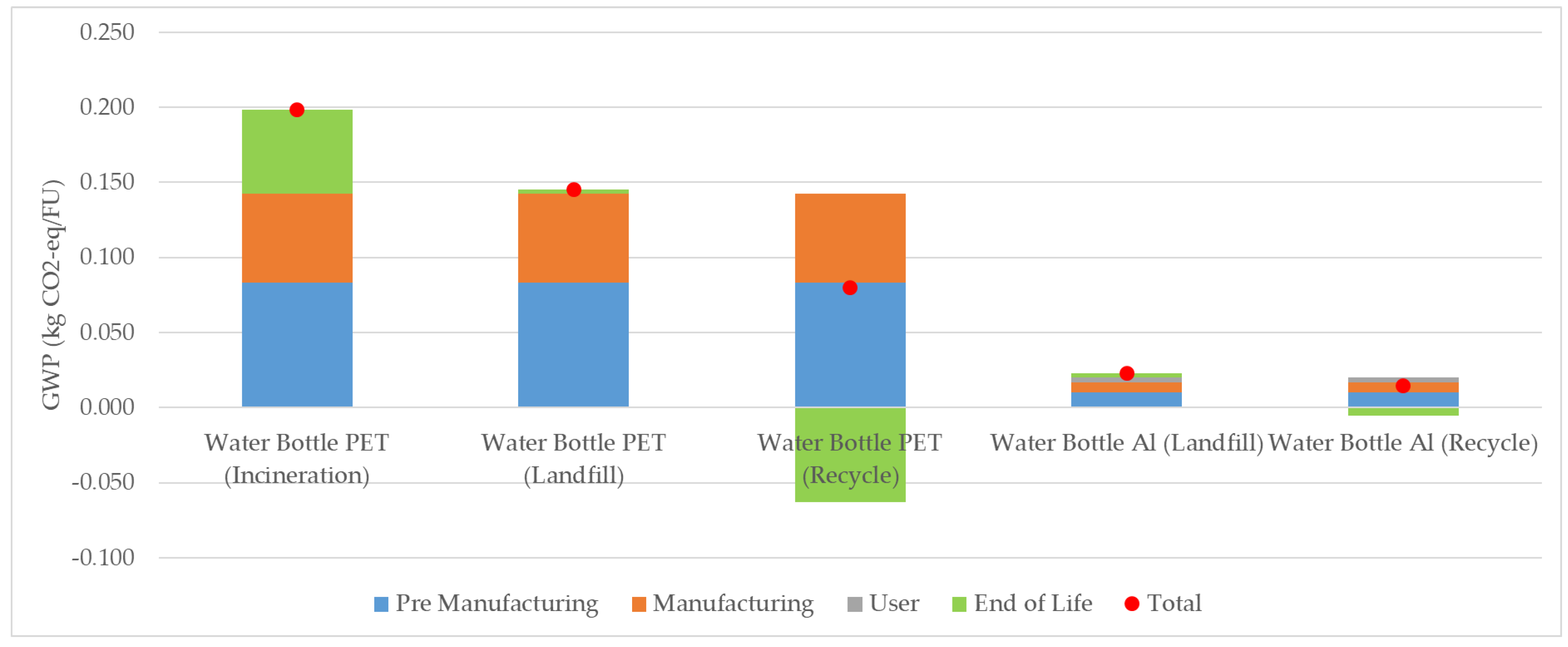
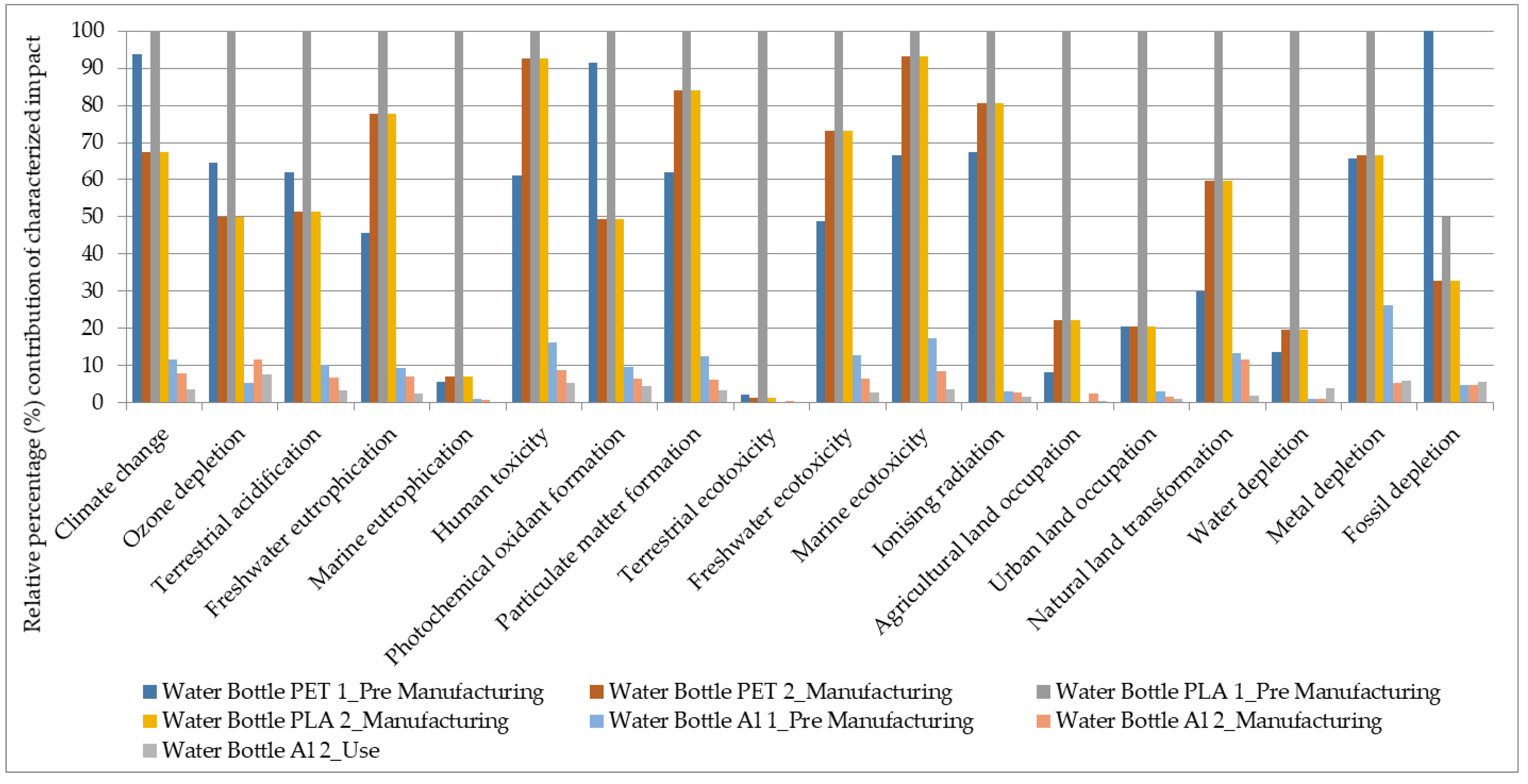
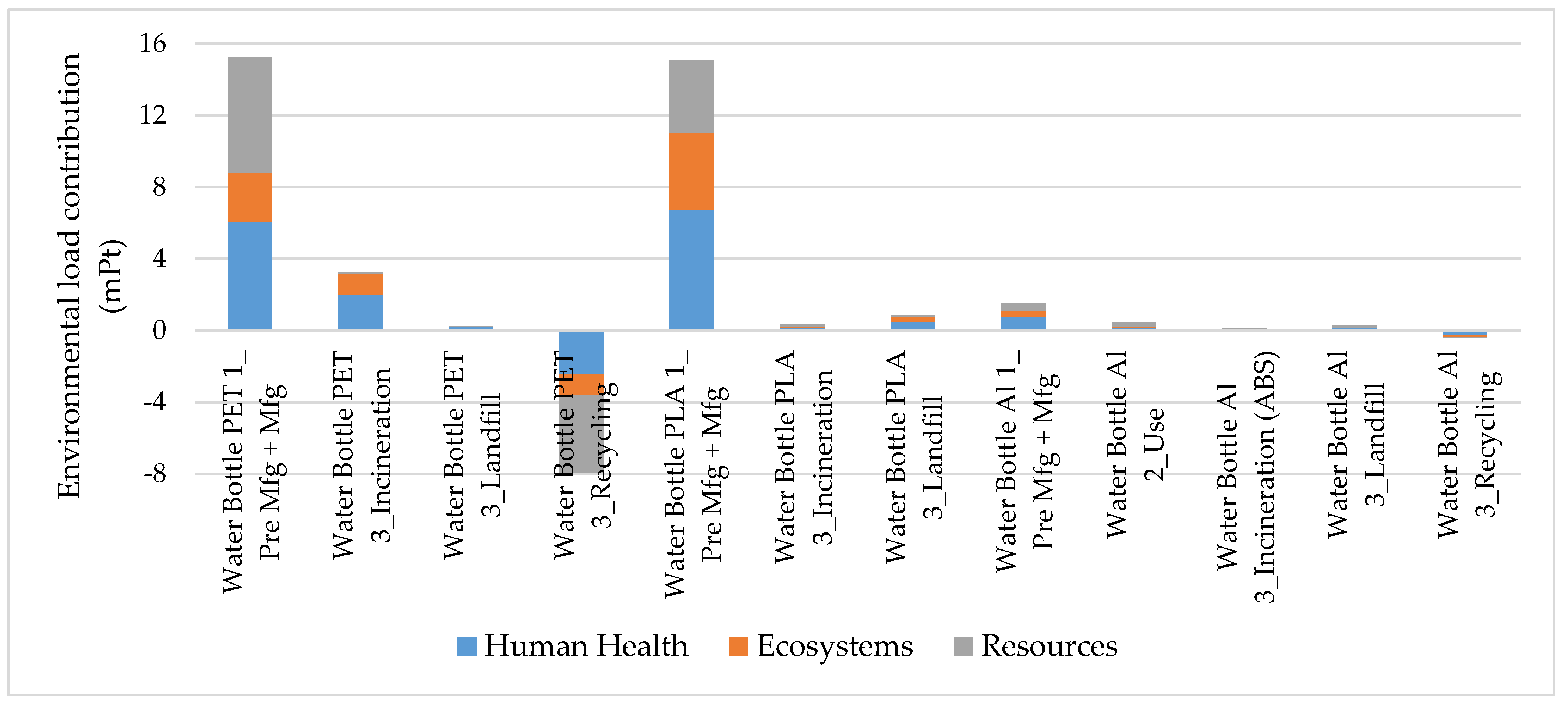
| Product | SUPPs | Alternative Products Considered |
|---|---|---|
| Cutlery Fork/Spoon | Polystyrene (PS) | Single-use: Polylactic Acid (PLA) Reusable: Steel (200 times reuse) |
| Cotton bud | Polypropylene (PP) | Single-use: Polylactic Acid (PLA) |
| Joss-Stick wrappers | Low-density polyethylene (LDPE) | Single-use: Polylactic Acid (PLA) |
| Cloth wick wrappers | Low-density polyethylene (LDPE) | Single-use: Polylactic Acid (PLA) |
| Pesticide bottle | High-density polyethylene (HDPE) Polyethylene terephthalate (PET) | Single-use: Polylactic Acid (PLA) |
| Grocery bag | Low-density polyethylene (LDPE) | Single-use: Polylactic Acid (PLA) |
| Straws | Polypropylene (PP) | Single-use: Polylactic Acid (PLA) |
| Water bottle | Polyethylene terephthalate (PET) | Single-use: Polylactic Acid (PLA) Reusable: Aluminium (200 times reuse) |
| SUPP | Studied SUPPs | |||||||
|---|---|---|---|---|---|---|---|---|
| Cutlery Fork/Spoon | Cotton Bud | Joss-Stick Wrappers | cloth wick Wrappers | Pesticide Bottle | Grocery Bag | Straws | Water Bottle | |
| Goals |
| |||||||
| Scope | Cradle-to-grave | |||||||
| The functional unit (FU) | 1-time use of cutlery fork/spoon | 1 cotton bud | 1 Joss-Stick wrapper | 1 cloth wick wrapper | 1-time use of <750 mL pesticide bottle | 1 grocery bag | 1 straw | 1-time use of 750 mL water bottle |
| Geographical boundary | Sri Lanka | |||||||
| Life cycle level-based boundary |
| |||||||
| Legal Instrument | Description | Reference |
|---|---|---|
| Constitution of 1978 and amendments till 2021 |
| [32] |
| The Code of Criminal Procedure Act No. 15 of 1979 and Penal Code Ordinance No. 2 of 1883. |
| [33] |
| The National Environmental Act (NEA) |
| [34] |
| National Environmental Policy of 2003 * |
| [35] |
| Cleaner Production Policy of 2004 |
| [36] |
| National Policy on Solid Waste Management of 2007 |
| [37] |
| Marine Pollution Prevention Act No.2 of 2008 |
| [38] |
| Environment Conservation Levy Act No.26, 2008 |
| [39] |
| Plastic Ban, 2017 |
| [25] |
| National Policy on Waste Management, 2019 |
| [40] |
| National Environmental Regulations 2021 |
| [41] |
| National action plan on plastic waste management 2021–2030 (NAPPWM) |
| [42] |
| SUPPs | LCA Observations | Recommended Policy Measures |
|---|---|---|
| Cutlery (Fork/Spoon) | The steel reusable cutlery shows comparatively lower environmental impact compared to both single-use products. The potential GWP reduction range is 0.01–0.05 kg CO2 (eq) per one-time use. Recycling of the SUPPs is environmentally better compared to PLA. Even though PLA is biodegradable and minimizes the impact if mismanaged, the pre-production process includes a higher environmental footprint. Nature-based products (such as Bamboo cutlery) provide a similar GWP footprint to the PS. However, this eliminates the plastic end-of-life impacts such as marine litter associated with human toxicity and eco-toxicity. |
|
| Cotton buds with plastic stem | If recycled, PP cotton buds are relatively low GWP to the PLA. However, the present waste management systems and the nature of the cotton buds make it difficult to integrate into the recycling process. Then environmental leakage is possible and contributes to the marine litter impacts. Hence the litter impacts, which are not estimated in present LCAs, should also be considered for decision-making. |
|
| Joss-Stick wrappers | If recycled, LDPE indicates a lower GWP compared to PLA (if there is no environmental leakage that induces potential impacts such as marine litter impacts). |
|
| cloth wick wrappers | If recycled, LDPE indicates a lower GWP compared to PLA (if there is no environmental leakage that induces potential impacts such as marine litter impacts). |
|
| Pesticide bottles ≤ 750 mL | HDPE indicates a slightly lower (7.6%) environmental impact than PET considering the end-of-life management as the incineration. Considering the hazardous nature of pesticide bottles, recycling, and landfilling options are not recommended in the present waste management system of the country. |
|
| Grocery bags | SUPPs show comparatively lower GWP than PLA. In general, if reusable bags (not considered in this study) are used about 50–150 times, the GWP impact will be lower than the SUPPs. |
|
| Straws | SUPPs show comparatively lower GWP than PLA. SUPPs recycling provided the largest GWP reduction. |
|
| Water Bottles | The reusable aluminum bottle shows a comparatively lower environmental impact than single-use products. |
|
Publisher’s Note: MDPI stays neutral with regard to jurisdictional claims in published maps and institutional affiliations. |
© 2022 by the authors. Licensee MDPI, Basel, Switzerland. This article is an open access article distributed under the terms and conditions of the Creative Commons Attribution (CC BY) license (https://creativecommons.org/licenses/by/4.0/).
Share and Cite
Kamalakkannan, S.; Abeynayaka, A.; Kulatunga, A.K.; Singh, R.K.; Tatsuno, M.; Gamaralalage, P.J.D. Life Cycle Assessment of Selected Single-Use Plastic Products towards Evidence-Based Policy Recommendations in Sri Lanka. Sustainability 2022, 14, 14170. https://doi.org/10.3390/su142114170
Kamalakkannan S, Abeynayaka A, Kulatunga AK, Singh RK, Tatsuno M, Gamaralalage PJD. Life Cycle Assessment of Selected Single-Use Plastic Products towards Evidence-Based Policy Recommendations in Sri Lanka. Sustainability. 2022; 14(21):14170. https://doi.org/10.3390/su142114170
Chicago/Turabian StyleKamalakkannan, Sivappirakasam, Amila Abeynayaka, Asela K. Kulatunga, Rajeev Kumar Singh, Miwa Tatsuno, and Premakumara Jagath Dickella Gamaralalage. 2022. "Life Cycle Assessment of Selected Single-Use Plastic Products towards Evidence-Based Policy Recommendations in Sri Lanka" Sustainability 14, no. 21: 14170. https://doi.org/10.3390/su142114170
APA StyleKamalakkannan, S., Abeynayaka, A., Kulatunga, A. K., Singh, R. K., Tatsuno, M., & Gamaralalage, P. J. D. (2022). Life Cycle Assessment of Selected Single-Use Plastic Products towards Evidence-Based Policy Recommendations in Sri Lanka. Sustainability, 14(21), 14170. https://doi.org/10.3390/su142114170







